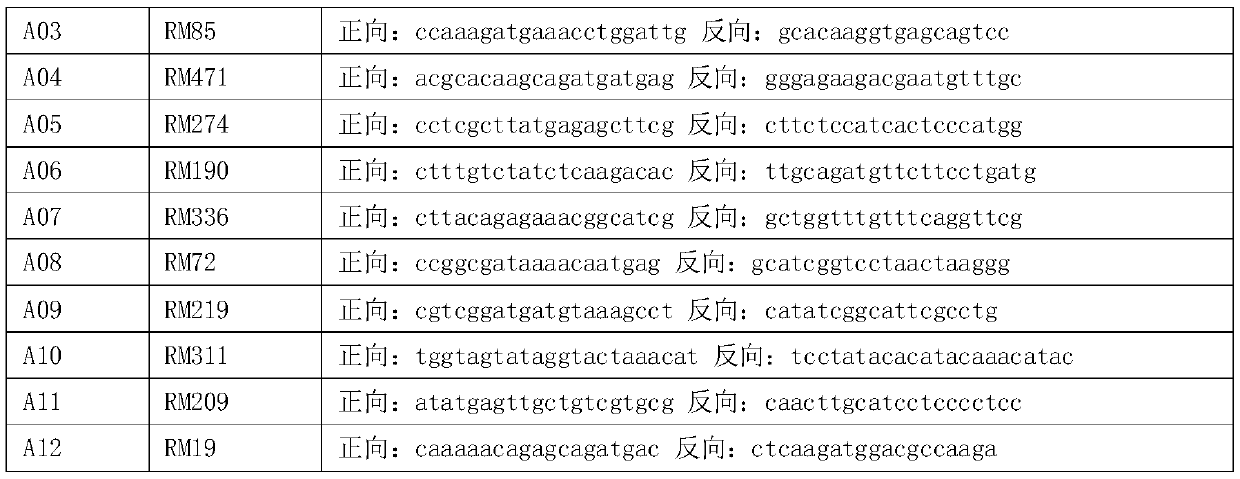A method for testing the purity and consistency of conventional rice varieties
A technology of species purity and consistency, applied in biochemical equipment and methods, microbial determination/inspection, etc., can solve the problems of large workload, low efficiency and high cost, and achieve the effect of overcoming high cost
- Summary
- Abstract
- Description
- Claims
- Application Information
AI Technical Summary
Problems solved by technology
Method used
Image
Examples
Embodiment 1
[0023] The plants of the conventional rice variety Chujing 27 were planted in 10 rows×10 columns, and each individual plant was positioned and numbered according to the rows and columns; , width are 1cm leaf tissue, after mixing, DNA is extracted according to the conventional CTAB method, and it is recorded as DNAa; the length and width of the first leaf middle section of each rice plant in column b are cut from the leaf tissue that is 1 cm in length and width, and after mixing The DNA was extracted according to the conventional CTAB method, which was recorded as DNAb, and the 12 SSR markers in group A published in the agricultural industry standard "SSR Marker Method for Identification of Rice Varieties" (NY / T 1433-2014) were used to amplify the mixed extracted DNA , and the amplified products were electrophoresed and stained. Specific amplification primers are as follows:
[0024]
[0025]
[0026] After analyzing the SSR amplification products, it was found that the ...
Embodiment 2
[0031] The plants of the conventional rice variety Xiujing 12 were planted in 10 rows×10 columns, and each individual plant was positioned and numbered according to the rows and columns; , width are 1cm leaf tissue, after mixing, DNA is extracted according to the conventional CTAB method, and it is recorded as DNAa; the length and width of the first leaf middle section of each rice plant in column b are cut from the leaf tissue that is 1 cm in length and width, and after mixing The DNA was extracted according to the conventional CTAB method, which was recorded as DNAb, and the 12 SSR markers in group A published in the agricultural industry standard "SSR Marker Method for Identification of Rice Varieties" (NY / T 1433-2014) were used to amplify the mixed extracted DNA , and the amplified products were electrophoresed and stained.
[0032] After analyzing the SSR amplification products, it was found that primers RM583 and RM19 amplified heterotypic bands in row 5 (R5) and column ...
Embodiment 3
[0037] Plant the plants of the conventional rice variety Yunjingyou No. 1 in 10 rows×10 columns, and position and number each individual plant according to the rows and columns; when the rice grows to the booting stage, cut the middle part of the first leaf of each rice plant in row a The length and width are 1cm leaf tissue, after mixing, DNA is extracted according to the conventional CTAB method, and it is recorded as DNAa; the length and width of the first leaf middle section of each rice plant in column b are cut from the leaf tissue of 1 cm in length, After mixing, the DNA was extracted according to the conventional CTAB method, which was recorded as DNAb, and the 12 SSR markers of group A published in the agricultural industry standard "SSR Marker Method for Identification of Rice Varieties" (NY / T 1433-2014) were used to carry out the DNA extraction. Amplify, and electrophoresis and stain the amplified product.
[0038] After analyzing the SSR amplification products, it ...
PUM
 Login to View More
Login to View More Abstract
Description
Claims
Application Information
 Login to View More
Login to View More - R&D
- Intellectual Property
- Life Sciences
- Materials
- Tech Scout
- Unparalleled Data Quality
- Higher Quality Content
- 60% Fewer Hallucinations
Browse by: Latest US Patents, China's latest patents, Technical Efficacy Thesaurus, Application Domain, Technology Topic, Popular Technical Reports.
© 2025 PatSnap. All rights reserved.Legal|Privacy policy|Modern Slavery Act Transparency Statement|Sitemap|About US| Contact US: help@patsnap.com


